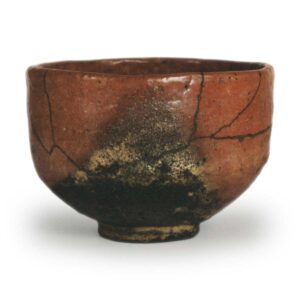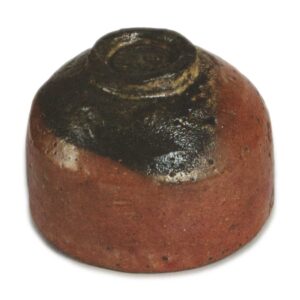

HATAKEYAMA MEMORIAL MUSEUM
Height: 8.0cm
Diameter: 11.2-11.5cm
Foot diameter: 4.7cm
Height: 0.8-0.9cm
Seven of the tea bowls made by Chojiro are considered to be masterpieces, and are called the “Seven Chojiro Types” and have been highly prized since early times. There is also another name for the Rikyu Seven, which is probably due to the fact that it is said that Chojiro’s tea bowls were made under the guidance of Rikyu.
The name “Hayafune” is said to come from the story that when Rikyu was in Osaka, he happened to need one of these tea bowls, so he had a fast boat made and sent from Kyoto to get it.
Of the seven tea bowls, four were red glazed and were named Hayafune, Kimori, Kengyo and Rinzai. However, Kengyo and Rinzai were lost early on, and Kimori was destroyed in the Great Kanto Earthquake of 1923, so that both the shape and glaze color are completely unrecognizable, and it is said to have been a tragic sight. Therefore, this “Hayafune” tea bowl is the only one that is close to a complete vessel in the so-called Sōyō style, a red tea bowl favored by Rikyū.
The rim is called ichimonji-zukuri, a style with no high or low points, and the rim is slightly scalloped. There are two large brush strokes on the waist, which run horizontally in a stepped pattern, so the boundary between the upright body and the waist is clearly defined. There are also brush strokes around the boundary between the waist and the foot ring, and around the back of the foot ring, so the foot ring is clearly defined, and the back of the foot ring is low and shaped like a comma.
The body is relatively thinly made, and red glaze is applied to the entire inside surface, most of the outside body, and part of the waist, while white glaze is applied to most of the waist, the foot, and the entire underside of the foot. The red glaze is a pale color, but it has a transparency that is unusual for Chojiro’s red glaze, so the color tone is very vivid. The white glaze that has accumulated on the body, waist, or around the foot of the vessel is gray in color, but the majority of the white glaze has turned a bluish-black color. Only two of the foot-ring marks are clearly visible, but the others are almost impossible to see. However, the irregular pentagonal marks on the inside bottom are clearly visible. They are also larger than the marks on the folded part of the rim, about half the size of an azuki bean. As they are broken into six pieces, the repair work can be seen in several places, from the rim to the waist.
This tea bowl was the most beloved of all by Rikyu. It is known that Rikyu was troubled by the request for this bowl from Ujisato Gamo and Tadaoki Hosokawa in the middle of the Tensho era, and the fact that a letter from Rikyu is included in the set, as well as the fact that the characters on the sandpaper on the box are said to be written by Rikyu, suggests that it was a treasured item of Rikyu’s. After being in the possession of Ujisato, it was passed down to Daimonjiya Soetsu, Kikyo-ya Rokuemon, and Yagura Kuemon in Kyoto. When Kueemon owned it, Matsudaira Fumai is said to have requested its transfer, but he did not achieve his goal. In 1876, it was sold to Toda Rogen, a tea utensil dealer in Osaka, and in 1880 it was sold to Kameda Korian in Kanazawa. It was then owned by Fujita Heitaro and Ohara Magosaburo before it came into the possession of the Hatakeyama Memorial Museum.



